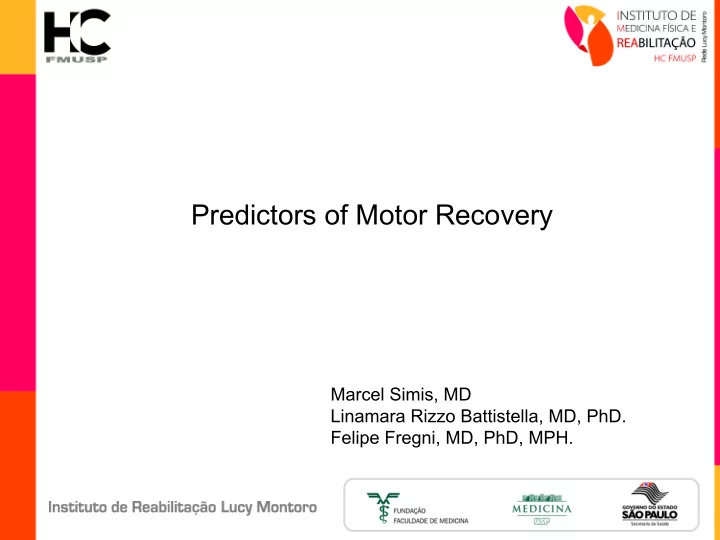

Predictors of Motor Recovery Marcel Simis, MD Linamara Rizzo Battistella, MD, PhD. Felipe Fregni, MD, PhD, MPH.
São Paulo City
Serving more than 100,000 patients per month.
Lin L. Zhu et al., 2010
mechanisms of neuronal plasticity Reorganization of neural networks Increase the "spines" of dendrites Changes in synaptic strength Knudsen, 2004, J Cogn Neurosc http://www.bristol.ac.uk/anatomy/images/jmhfig2.jpg
TMS Barker AT, et al., 1985
Motor Evoked Potential Kobayashi M and Pascual-Leone A. THE LANCET Neurology Vol 2 March 2003
Motor threshold • Lowest stimulus (applied in an appropriate place) capable of generating a motor evoked potential (MEP) with minimum amplitude of 50μV in at least 50% of applications Kobayashi M and Pascual-Leone A. THE LANCET Neurology Vol 2 March 2003
Silent Period Kobayashi M and Pascual-Leone A. THE LANCET Neurology Vol 2 March 2003
Paired pulse • Conditioning pulse (80% MT) • Test pulse (1-5 ms) (10-15 ms) Kobayashi M and Pascual-Leone A. THE LANCET Neurology Vol 2 March 2003
So what?
Prognosis High motor thresholds or a complete absence of MEPs in the paretic hand after subacute stroke are associated with poorer prognosis in terms of motor recovery
Prognosis Surrogate outcome Efficacy of treatment To Guide therapies
Interhemispheric Imbalance Martin PI et al., 2009
Neuromodulation Therapies
• (Stroke . 2006;37:2115-2122.)
Neurologic recovery of stroke: neurophysiological measurements of affected and unaffected motor cortex – a cross-sectional, multi-center individual patient data analysis study • Marcel Simis 1, 2 • Vincenzo Di Lazzaro 3 • Adam Kirton 4 • Giovanni Pennisi 5 • Rita Bella 5 • Yun-Hee Kim 6 • Naoyuki Takeuchi 7 • Eman M Khedr 8 • Lynn M. Rogers 9, 10 • Richard Harvey 9, 10 • Satoko Koganemaru 11 12 • Bulent Turman 13 • Sultan Tarlacı 14 • Rubens J. Gagliardi 2 • Felipe Fregni 1 • 1 Laboratory of Neuromodulation, Spaulding Rehabilitation Hospital and Massachusetts General Hospital, Harvard Medical School, Boston, US • 2 Division of Neurology, Santa Casa Medical School, Sao Paulo, Brazil • 3 Institute of Neurology, Università Campus Biomedico, Rome, Italy • 4 Calgary Pediatric Stroke Program, Alberta Children’s Hospital Research Institute, University of Calgary, Calgary, Alberta, Canada • 5 Department GF Ingrassia, Section of Neurosciences, University of Catania, Italy • 6 Department of Physical and Rehabilitation Medicine, Stroke and Cerebrovascular Center, Samsung Medical Center, Sungkyunkwan University School of Medicine, Seoul, Republic of Korea • 7 Department of Physical Medicine and Rehabilitation, Tohoku University Graduates School of Medicine, Sendai, Japan • 8 Department of Neurology, Faculty of Medicine, Assiut University Hospital, Assuit, EGYPT • 9 Sensory Motor Performance Program, Rehabilitation Institute of Chicago, Chicago, US • 10 Department of Physical Medicine and Rehabilitation, Northwestern University Feinberg School of Medicine, Chicago, US • 11 Department of Brain Pathophysiology, Human Brain Research Center, Kyoto University Graduate School of Medicine, Kyoto, Japan • 12 Department of Physical and Rehabilitation Medicine, Hyogo College of Medicine, Nishinomiya, Japan • 13 School of Medicine, Bond University, Australia. • 14 Universal Special Health Hospital, Alsancak, Izmir, Turkey.
Linear regression model • dependent variables: -Motor Threshold • independent variables: -age -Gender -lesion side (right or left) -single stroke (yes or no), -time since stroke (in months), -stroke mechanism (ischemic or hemorrhagic) -site of the lesion (divided in exclusive cortical and not exclusive cortical) -severity of motor deficit -Centers with dummy variable
Final
Limitation - Limited information about cortical excitability - Just cross sectional
NARLE X “InMotion ARM™ Robot” Constraint-induced movement therapy
NARLE
NARLE Linear regression model • dependent variables: -Variation in Motor function • independent variables: -Cortical excitability -EEG -age -gender -lesion side (right or left) -Number of stroke, -time since stroke (in months), -stroke mechanism (ischemic or hemorrhagic) -site of the lesion -severity of motor deficit -use of medications with impact on the central nervous -comorbidities -BDNF
Robotics for assessment of performance kinematics Pre – training Post - training
NARLE How to measure severity of motor deficit? World Health Organization International Classification of Functioning, Disability and Health (WHO-ICF) - Impairment - Activity Limitations - Participation Restrictions psychometric properties -validity, -reliability, -responsiveness
Predictors of Motor Recovery
Thank you marcel.simis@hc.fm.usp.br
Recommend
More recommend